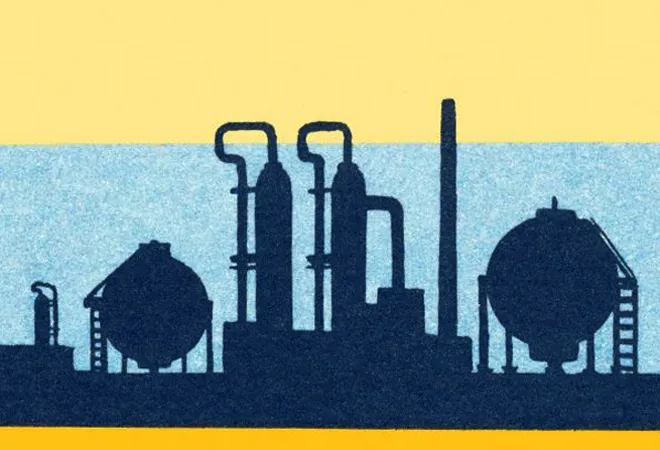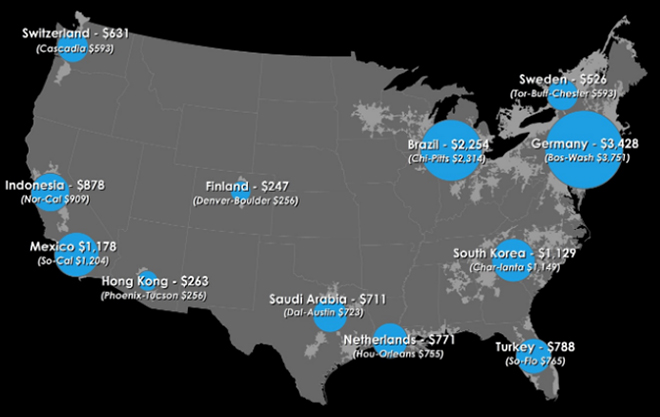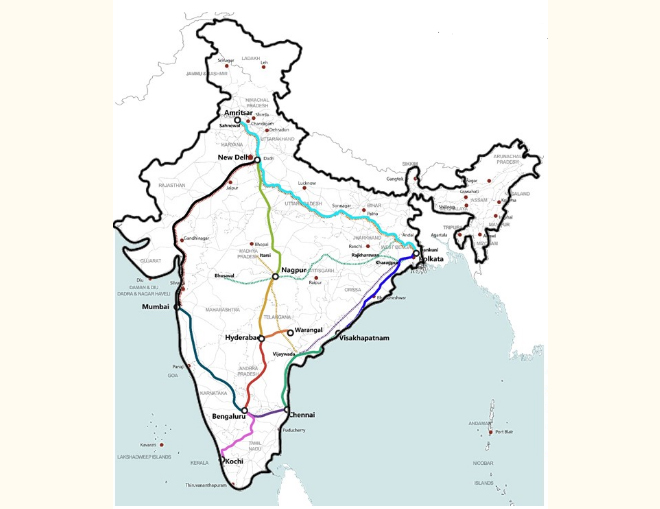
Conventional economic frameworks posit that the economy is a well-oiled machinery that tends to be in a steady state equilibrium. However, the complexity framework refutes this paradigm and posits that the economy is an ever-changing process phenomenon that perpetually constructs itself anew. But every milestone in the economy is a product of the past, and hence policy decisions leading the economic journeys are path dependent. In that sense, economic decisions and reforms are not a sprint but a relay race where different types of economic reforms are required at various stages of a nation’s economic journey for the next reform measure to take shape. At this leg of India’s development journey, industrial corridor development will leverage the potential of various levers of the economy and provide for environmentally sustainable and socially equitable growth. When executed well, industrial corridors have a positive bearing on several aspects such as infrastructure development, skill development, employment, income growth, labour productivity, business competitiveness and trade.
An industrial corridor is an economic ecosystem built around a transportation corridor connecting two major economic centres, where the transportation corridor serves as the nerve centre of the economic activity across the corridor. In addition to the transportation corridor, a well-designed industrial corridor contains clusters of industrial production serving regional and global demand, and urban centers proliferating equitable development. The core goals of an industrial corridor are:
• Attracting investments and creating jobs in the manufacturing sector
• Increasing the contribution of manufacturing sector to GDP
• Promoting equitable industrialisation and urbanisation
• Increasing labour productivity and income levels
The economic power of industrial corridors has been empirically observed and validated. The 500 miles Bos-Wash economic corridor is the world’s most popular economic corridor, and extends from Boston to Washington, via New York, Baltimore and Philadelphia. This corridor alone accounts for an economic output totaling US$ 3.7 trillion, equaling Germany’s GDP and 19-20% of the United States’ GDP. Even the smallest of such corridors in the United States, the 29-mile Denver-Boulder industrial corridor, generates US$ 256 billion in economic output, outperforming economic output of high-income nations such as Finland and Ireland. At an economic output of US$ 13.2 trillion, the twelve industrial corridors in the United States account for 86.8% of China’s GDP.
 Industrial corridors in the USA | Source: Bloomberg
Industrial corridors in the USA | Source: Bloomberg
 Industrial corridors compared to countries | Source: Bloomberg
Industrial corridors compared to countries | Source: Bloomberg
India’s tryst with industrial corridors began in 2006, when India and Japan signed a memorandum of understanding for developing the Delhi-Mumbai Industrial Corridor (DMIC), which connects the two cities and passes through six states. Upon completion, DMIC is expected to create 25 million jobs predominantly in the manufacturing sector. The DMIC is inspired by the Tokaido Corridor in Japan, the 1,200 kms corridor connecting Osaka and Tokyo, which alone accounts for a staggering 80% of Japan’s GDP.
Currently, there are eleven industrial corridor projects that the central government has approved, for funding and implementation through the National Infrastructure Corridor Development Corporation. These corridors, connecting some of India’s key economic centres, have the potential to make India a global manufacturing hub.
 Proposed industrial corridors | Source: NICDC
Proposed industrial corridors | Source: NICDC
While committing to build industrial corridors connecting various economic centers is a welcome measure, the real challenge lies in ensuring that the Indian government’s enormous investments result in these corridors becoming engines of regional and national economic growth. In order to achieve this, there is a need for a National Industrial Corridor Development Framework that synchronises the efforts across various industrial corridors, in a manner that they complement each other. The framework must focus on the following aspects:
1. Relative comparative advantage of industries
2. Cluster differentiation
3. Cluster urbanisation
4. Infrastructure development
5. Nurturing corridor centric MSME ecosystem development
6. Corridor-centric skill development roadmap
7. Land and labour reforms
Relative comparative advantage of industries: The success of industrial corridors lies in developing industries that have a strong relative comparative advantage. While a geographic region could produce many goods, it will have relative comparative advantage only in certain types of industrial production. By focusing on production of goods in which a nation has no relative comparative advantage, it loses out on the economic advantages of producing goods over which it has an advantage. This rule is applicable even among economic regions within a nation. For the various industrial clusters along the industrial corridors to be integrated with the global and regional value chains, the industries in these regions must have a relative comparative advantage. India has a relative comparative advantage in the following sectors, and must focus on developing manufacturing industries in these sectors only:
i. Auto and auto components
ii. Chemicals and petrochemicals
iii. Electronics
iv. Engineering equipment
v. Fabricated metal
vi. Food processing
vii. Furniture and wood
viii. Gems and jewellery
ix. Glass
x. Leather
xi. Medical equipment
xii. Mining, minerals and metallurgy
xiii. Paper and paper products
xiv. Pharmaceuticals
xv. Printing and media
xvi. Rubber
xvii. Textiles
xviii. Transportation equipment
These sectors also have their advantages limited to certain regions within India. For instance, despite their advanced industrialisation, Tamil Nadu or Karnataka cannot compete with Gujarat on gems and jewellery making, and most states cannot compete with these two states on auto and auto components manufacturing. India’s industrial corridor roadmap must, therefore, be centered around the intelligent distribution of focus on sectors with comparative advantages and enabling infrastructure investments must be made accordingly. In the name of competitive federalism, states mustn’t compete in a manner that India’s comparative advantage gets dissipated — backward and forward linkage synergies must be built in a manner that India’s comparative advantage expands to exploit global opportunities.
Cluster differentiation: While every district through which an industrial corridor passes has the potential to be a manufacturing cluster, the potential isn’t uniform, and therefore the clusters that need to be developed must be selected based on the following criteria:
• Existing forward and backward linkages (depending on the type of industry)
• Land availability for development of new industrial clusters
• Skill availability
• Level of industrial agglomeration
• Proximity to urban centers and transportation gateways such as ports
• Logistical connectivity
• Availability of power and water
Based on the varying levels of fulfillment of the above criteria, clusters must be differentiated as high-production clusters, medium-production clusters and low-production clusters, and priority-based investments need to be made accordingly.
Cluster urbanisation: Once the core sectors are identified, a synchronised strategy for urbanisation and infrastructure development must be developed and implemented. The districts housing the clusters must also be developed as urban centers, designed to absorb labour from the neighboring districts — such proliferation or urbanisation is also the solution for India’s migrant labour crisis. Through the smart city and other urbanisation programmes of the government, concentrated efforts must be made to increase the urbanisation quotient of these districts.
Infrastructure development: While the transportation corridor will serve as the spine, robust grid networks need to be developed, connecting the clusters to the hinterlands and gateways. For example, the Odisha government is developing the Biju-expressway corridor connecting its most backward districts along its western border, some of which are Naxal hit regions. Many do not have rail connectivity and did not have mobile connectivity until recently. While its success is predicated on cluster differentiation, and in choosing the right kind of industries for development within these clusters, the importance of integrating the corridor with the Eastern Economic Corridor (running through Odisha and connecting Vishakhapatnam with Kolkata), and to other gateways such as the Pradeep and Vishakhapatnam ports cannot be over emphasised. As part of the infrastructure development measures, infrastructure specific to promoting cluster enablement and competitiveness must also be developed.
Nurturing corridor centric MSME ecosystem: In addition to investing in and building the enabling infrastructure, the central and state governments must focus on promoting ease of doing business and developing a MSME-centric supplier ecosystem within these corridors. Integration of MSMEs to the overall economic activity of the industrial corridor will be central to expanding industrial output, generating employment opportunities, enhancing labour productivity and increasing wages – key components of equitable economic development. This would also result in pulling millions of people into the economic middle class strata.
Corridor centric skill-development roadmap: Skill availability is a key determinant of private sector investment decisions. All industrial corridors must also have a skill agenda, tailored specifically to meet the skill requirements of the corridors with short-term, medium-term and long-term plans. The roadmap must be developed in collaboration with the industry and academia and must aim to provide a significant skill advantage to the region.
Land and labour reforms: By design, most parts of an industrial corridor pass through rural or semi-rural areas where the quantum of agricultural land holdings is high. For manufacturing industries to be set-up in these regions, land needs to be acquired and labour needs to be employed. In order to attract investments for setting up manufacturing industries, land acquisition and labour laws must be progressive and investment friendly, calling for institutional reforms in this area.
India’s economic trajectory is very uneven. While it’s the third largest economy by PPP, it stands at 142 in terms of GDP-per capita (IMF World Economic Outlook Data). The top 10% of the Indian population holds 77% of the total national wealth. 73% of the wealth generated in 2017 went to the richest 1%, while 67 million Indians who comprise the poorest half of the population saw only a 1% increase in their wealth. Such inequality cannot be removed by government welfare measures alone. It calls for the involvement of millions of people — who are otherwise not a part of the economic mainstream — to be integrated into the wealth and value creation process; this is where industrial corridors offer a panacea. The power of an industrial corridor lies in its ability to mobilise many moving parts of the economy and institutionalise many factors required for equitable and sustained economic growth. Therefore, India needs a National Industrial Corridor Development Framework that builds over the good work in the recent past and provides a twenty-five-year vision, strategy and implementation roadmap where the national government and all the state governments come together to realise a unified national vision of making India a global manufacturing hub.
The views expressed above belong to the author(s). ORF research and analyses now available on Telegram! Click here to access our curated content — blogs, longforms and interviews.




 Industrial corridors in the USA | Source: Bloomberg
Industrial corridors in the USA | Source: Bloomberg Industrial corridors compared to countries | Source: Bloomberg
Industrial corridors compared to countries | Source: Bloomberg Proposed industrial corridors | Source: NICDC
Proposed industrial corridors | Source: NICDC PREV
PREV


